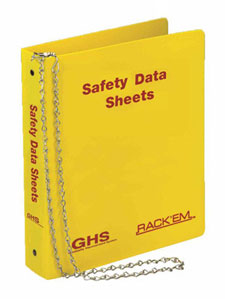| The Home page of ILPI's Safety Data Sheet (SDS) Resource, the leader in SDS information since 1995! | |
| The history and philosophy behind this resource. | |
| A curated collection of books and reference materials concerning Safety Data Sheets and closely related topics. | |
| Paste your plain text SDS into the SDS-Demystifier, and it will be converted into a hypertext-enriched document with links to detailed explanations of each key term. | |
| An extensive list of frequently asked questions about Safety Data Sheets including regulations, content, compliance, and more. | |
| A humorous take on Safety Data Sheet jargon. Fill in the blanks on our entry form to generate a personalized Unsafety Data Sheet to share with your coworkers. | |
| Since 1995, we've maintained this massive curated list of the best places to find Safety Data Sheets on the Internet. | |
| Way more than a glossary, this hypertext-enhanced resource covers hundreds of SDS-related terms and expert knowledge. Each entry includes both the SDS relevance and links to additional authoritative resources. | |
| Archived results of Safety Data Sheet related polls taken by some of our millions of site visitors | |
| You are here! The OSHA regulations behind SDS regulations, including the inspection guidelines and over 400 official interpretations letters under the Hazard Communication Standard | |
| Commercial suppliers of SDS authoring and management software as well as cloud compliance services. | |
| Commercial companies that will create SDS's for your specific needs as well as SDS translation companies. |

Safety signs, banners, and scoreboards? Get yours at Safety Emporium!
| Title: 01/24/1990 - The hazard communication standard requirements for food or food additives. | |
| Record Type: Interpretation | Standard Number: 1910.1200 |
January 24, 1990
Mr. John E. Lee, III
Director of Safety and Loss Control
National Oats Company [bought by Ralston in 1994; bought by ConAgra in 2013]
1515 H Avenue, N.E.
Cedar Rapids, Iowa 52402
Dear Mr. Lee:
This is in response to your letter of November 27, 1989, to Mr. Barry White, Director of the Occupational Safety and Health Administration's (OSHA) Directorate of Safety Standards Programs. Your letter, which raised concerns about the applicability of OSHA's Hazard Communication Standard, (HCS) 29 CFR 1910.1200, was referred to me; please allow me to apologize for the delay of this response.

Get your SDS binders, centers and more from Safety Emporium.
You specifically questioned "whether food products are guided by the OSHA Standard 1910.1200?" The HCS, at section (b)(5)(ii) specifically exempts from the labeling requirements of the HCS any food or food additive that is subject to the labeling requirements of the Food and Drug Administration (FDA). In addition, section (b)(6)(v) states that the entire standard does not apply to "Food, drugs, cosmetics or alcoholic beverages in a retail establishment which are packaged for sale to consumers." Food and food products are therefore not totally exempt from coverage under the provisions of the HCS.
Chemical manufacturers and importers are responsible for performing a hazard determination on the chemicals they produce to determine if, under normal conditions of use, their product could result in a hazardous exposure situation for downstream employees who will be working with or otherwise handling that product. "Chemical" is broadly defined in the HCS as "any element, chemical compound, or mixture of elements and/or compounds," and therefore includes food and food additives. Food products, like any other chemical product, must be evaluated for their downstream hazardous exposure potential. If there is no potential for worker exposure to any health or physical hazard (as defined in Appendix A of the standard), then the product is not subject to the provisions of the HCS and no material safety data sheet (MSDS) need be prepared for it.
As an example, workers who work with flour may be exposed to the potential hazards of explosion and or combustion which may occur if flour becomes airborne in sufficient concentrations. This certainly represents a potential physical hazard which would have to be noted on an accompanying MSDS for that (food) product.
I hope this helps clarify the concerns you raised. For your further reference I am enclosing a copy of the final Hazard Communication Standard as published in the Federal Register August 24, 1987. Please feel free to contact me again if I can be of further assistance.
Thomas J. Shepich, Director
Directorate of Compliance Programs
The original official public domain version of this document is available from OSHA at https://www.osha.gov/laws-regs/standardinterpretations/1990-01-24-0.